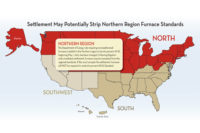The focus on chiller operational efficiency is changing as new ASHRAE standards are reaching the market. Some in the industry have described ASHRAE Standard 90.1 as a complex standard, especially when it comes to the enhanced chiller performance metrics included in versions 2010 and 2013. Yet, overall, chiller experts say the shift in the standard to a more holistic view of chiller efficiency is the right direction for the industry.
Shifting Standards
According to Laura Wand, vice president, chiller solutions, Johnson Controls Inc., “The latest versions of the standard [ASHRAE 90.1] elevate the importance of off-design conditions.” Wand said Johnson Controls agrees with this direction for evaluating efficiency since “design point typically only represents 1 percent of the annual operation.”
In contrast to a focus on full-load conditions, she said, “Chiller performance must be optimized over the entire range in which the chiller will operate, not just at the design point.”
Rob Landes, product manager, positive displacement chillers, Daikin Applied, further explained how the most recent versions of the standard have changed.
“I believe the most significant change with the 2010 and 2013 versions of ASHRAE 90.1 is the recognition of off-design performance and the impact it has on annual energy consumption,” he said. “There is now a Path A and Path B compliance track for both air- and water-cooled equipment. This recognizes that most operation occurs away from full-load design conditions, either at part- or full-load performance with reduced condensing temperatures. The IPLV [Integrated Part-Load Value] is a good indicator of annual energy performance.”
Plus, Landes noted, that version 2013 of the standard calls for increased efficiency in all chillers.
From his perspective as an expert in data center applications, Greg Haggy, product manager, Emerson Network Power, said the recent versions of ASHRAE 90.1 have had a significant impact on the design of all mechanical equipment for data centers — including chillers, of course.
“The 2013 revision of the standard requires EER ratings for air-cooled chillers that represent more than a 5 percent increase in required efficiency over the 2010 edition. More critically, 2013 includes an almost 10 percent increase in the required part-load efficiencies of chiller systems,” he said.
Haggy added he believes the part-load efficiency is a more accurate measure of a chiller’s real-world performance.
Adoption Process
While the new versions of ASHRAE 90.1 promote the importance of off-design and part-load efficiency, it may be a while before the impact of this is fully realized in the market. Currently, 18 states have adopted version 2010 of ASHRAE Standard 90.1, and only two states — Maryland and Vermont — have adopted the 2013 version of the standard.
“We have not seen many requests or specifications to meet the new standard from customers yet,” Landes said. “Because most states are a little slower to adopt the new standards, there is usually a delay in the time between when the standard is enacted and the appearance of the requirement in customer specifications. However, because we’ve already taken steps to meet the standard, we are ready to respond to those requirements.”
Haggy also noted Emerson Network Power’s mission-critical air-cooled chillers exceed ASHRAE efficiency requirements for both full- and part-load conditions.
“Beyond knowing what states have already adopted the code, we can’t predict when states will adopt new versions of 90.1, so we make sure to keep our product offerings in line with all coming standards to ensure we will be ready when additional states adopt new requirements,” he said.
Plus, Haggy pointed out, Maryland’s adoption of the 2013 version has the potential for significant impact due to the “large amount of data center activity in the Washington, District of Columbia, area.”
Wand described Johnson Controls’ approach as designing products that cover a range of efficiency levels, from meeting to exceeding industry standards.
“As standards advance, our newest lines are already in compliance, and we prune the lower-efficiency models that fall short of the new minimum efficiencies,” she explained. “Our focus is to develop a broad and flexible portfolio of products that can be tailored to specific customer needs.”
Moreover, she noted, while the state adoption of new efficiency codes may be slow, the industry continues to forge ahead.
“While code adoption is often slow and occurs on a state-by-state basis, our industry is progressive when it comes to looking ahead over the life of equipment,” Wand said. “The consulting engineering community often preempts the codes and standards by updating their specifications to be on the leading edge of performance.”
Publication date: 5/11/2015
Want more HVAC industry news and information? Join The NEWS on Facebook, Twitter, and LinkedIn today!









